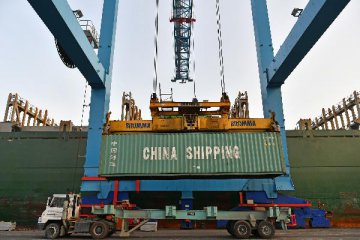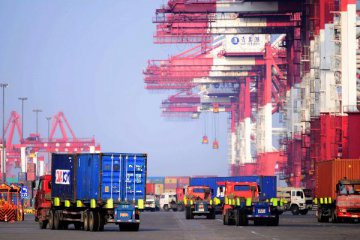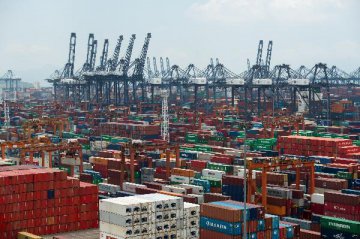
China has recently released a national plan for the development of foreign trade in the 13th Five-Year (2016-2020) Plan period.
The plan laid out the primary tasks and development goal for foreign trade during 2016-2020.
China should shift away from an obsession with growth and focus more on long-term structural adjustment, and at the same time nurture new growth engine for sustainable development of foreign trade, Sun Jiwen, spokesman for the Ministry of Commerce, said at a recent press briefing.
Due to weakening external demand, rising trade protectionism and downward pressure on foreign trade, prospects for China's foreign trade remain challenging in 2017, said Sun, adding that with the changes of foreign trade environment, China's foreign trade has entered a new stage of development.
At present, China is the only country in the world where total export value exceeds 2 trillion U.S. dollars.
However, traditional advantages rising from China's low-cost manufacturing will be gradually weakening due to rising price of essential productive factors and environmental pressure.
China should strive to press ahead with supply-side structural reform, speed up the transformation of foreign trade patterns, cultivate new competitive strengths and consolidate China's position as a global trading power, Sun also noted.
In 2016, China's total export and import value amounted to 24.33 trillion yuan, down 0.9 percent year on year, according to data from the General Administration of Customs (GAC).
Besides, China has great potential for trade with countries along the "Belt and Road", and meanwhile new business pattern, like cross-border e-commerce platform, is also worth of attention.
Trade with countries along the "Belt and Road" witnessed strong growth in 2016.
Trade between China and the Belt and Road countries came up to 848.9 billion U.S. dollars, exceeding 25 percent of China's total foreign trade volume during the first 11 months of 2016.
China's exports to Pakistan, Russia, Poland, Bangladesh and India in 2016 increase 11 percent, 14.1 percent, 11.8 percent, 9 percent and 6.5 percent respectively year on year, latest data from the GAC showed.
Meanwhile, economic and trade cooperation between China and the five Central Asia states, including Kazakhstan, Kyrgyzstan, Tajikistan, Turkmenistan and Uzbekistan, has been developing rapidly.
China has become the largest trade partner of Kyrgyzstan and Turkmenistan, and the second-largest trade partner of Kazakhstan, Uzbekistan and Tajikistan.
In last year, over 100 countries and international organizations have given warm responses and support to the Belt and Road Initiative, and more than 40 countries and international organizations have signed cooperation agreements with China.
China's outbound direct investment in Belt and Road counties stood at 13.4 billion U.S. dollars from January to November, accounting for 8.3 percent of the country's total ODI volume in the same period.
Chinese enterprises invested more than 18 billion U.S. dollars in countries along the "Belt and Road" while paying over 1 billion U.S. dollars in taxes and creating nearly 160,000 local jobs.
At the same time, China has witnessed a booming cross-border e-commerce sector. In 2015, China's transaction volume of cross-border e-commerce accounted for 19.5 percent of the country's total export and import value, which means cross-border e-commerce has become one of the most important patterns of foreign trade.
Data from the iiMedia Research showed that China's total transaction volume of cross-border e-commerce platforms amounted to 6.3 trillion yuan in 2016 and was expected to reach 8.8 trillion yuan in 2018.
The volume of cross-border e-commerce was estimated to approach 12 trillion yuan by 2020, according to a report released by CIConsulting.
Besides, cross-border e-commerce between China and Russia are also gaining traction. Russia has become the second largest country in terms of cross-border ecommerce with China.
Data from the Ministry of Commerce (MOC) showed that the transaction value of China-Russia cross-border e-commerce reached 1.15 billion U.S. dollars in the first half of 2016.
As a new trade pattern, cross-border e-commerce plays a positive role in promoting bilateral trade growth, said Sun, adding that the MOC will further deepen cross-border e-commerce cooperation between China and Russia in a bid to shift growth model from quantity-oriented to quality-oriented.
Wang Jian, professor at the University of International Business and Economics, said that new business patterns, such as cross-border e-commerce, might be a major breakthrough for foreign trade transformation, which will also bring a series of innovation covering policy formulation and supervisory measures.
























Latest comments